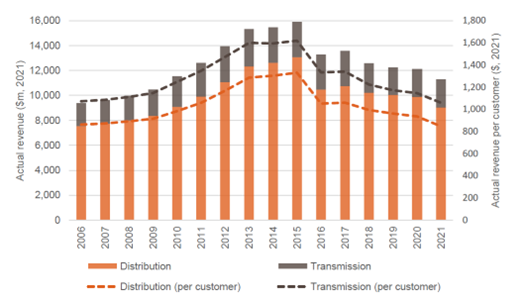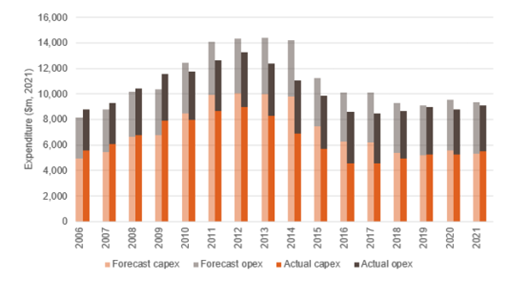Performance Report: Networks putting customers first
The Australian Energy Regulator’s (AER) 2022 Electricity Network Performance Report is an annual snapshot of the operational and financial performance of regulated electricity networks, known collectively as network service providers, or NSPs. This is the third such report that the AER has produced. Each report also takes a deep dive into key focus areas, with this year’s looking into the impact of extreme events and the progress of tariff reform in further detail, both important issues to consider in the energy transition.
Network charges continuing a downward trend
“Consumers paid less for electricity transmission and distribution services in 2021 with network revenue being 5.6% lower than 2020, continuing its downward trend since 2015. Network maintenance and service quality were still strong, with customers experiencing fewer and shorter outages on average than in 2020.” – AER[i]
Consumers’ electricity bills comprise several components, including network costs, wholesale market costs, retail margins and jurisdictional costs. As shown in Figure 1 below, in regulatory year 2021 electricity NSPs charged customers in total less for network services than they have at any time since 2010, which means that customers are continuing to pay less for the network component of their electricity bill.
This reduction in network revenue, about 5.6 per cent lower than in 2020, is complemented by improved service performance – outages were fewer and shorter on average than in 2020, including normalised outages (i.e., unplanned outages less excluded events such as major event days), as well as total outages that customers experienced.
Figure 1: Total core regulated network service revenue recovered from consumers – distribution and transmission network service providers
Source: AER, 2022 Electricity Network Performance Report, pg. 7.
Incentive regulation delivering for consumers
Australia’s energy networks are regulated through an incentive-based system that encourages them to find better ways to serve customers. All electricity NSPs are now regulated under revenue caps, and the AER’s incentive schemes enhance the overall regulatory framework by ensuring that businesses have a strengthened and constant incentive to continually lower their costs and improve service performance.
On an overall industry basis, incentive payments to network businesses were positive in 2021, largely driven by reliability improvement payments under the Service Target Performance Incentive Scheme, which ensures that service performance is maintained or improved even as networks seek cost efficiencies under the expenditure incentive schemes. As highlighted by the AER in the report, it is reviewing its incentive schemes to ensure they remain relevant and fit for purpose.
In assessing the effectiveness of incentive schemes, it is important to consider not only the benefits to networks (in the form of incentive payments) but also the benefits that consumers receive from networks responding to the AER’s incentives.
As part of an engagement for ENA, HoustonKemp independently quantified that consumers with an electricity service are $1,290 better off because of the incentive schemes[ii], and importantly, HoustonKemp’s analysis also demonstrates that most benefits of the schemes accrue to consumers rather than to networks.
As mentioned above, the AER regulates revenue and not expenditure. As shown in Figure 2, in 2021, while expenditure increases were lower than what was forecast overall, they were slightly higher than what was forecast for capital expenditure, continuing the trend of a tightening between forecast and actual expenditure.
Figure 2: Total expenditure – distribution and transmission network service providers
Source: AER, 2022 Electricity Network Performance Report, pg. 11.
Resilience matters
The AER’s report also looks at the impact of extreme events on reliability, insurance and network expenditure. While outages in 2021 were fewer and shorter on average than in 2020, over the past few years large outages have occurred on days in which a major event has occurred with a material effect on the magnitude of specific interruptions that customers experience.
Along with a recent AER resilience guideline release, distribution NSPs in NSW, ACT, TAS and NT are consulting on network resilience for their upcoming 2024-29 regulatory determinations looking at how distribution NSPs can best support the communities they serve in adapting to a changing climate. Network resilience, as highlighted by the AER, will likely be a key feature of upcoming regulatory proposals, and a continued topic of interest for NSPs and consumers alike.
Looking ahead
Networks are continuing to perform and deliver for customers.
It is important that these performance trends and results are fully considered in current and anticipated AER reviews. As an example, a past disparity between forecasts and actual expenditure has significantly tightened in recent times. For AER reviews like that currently examining the overall performance of incentive schemes these trends may contain a caution to ensure we are not solving for problems of the past rather than truly looking towards the future.
[i] AER, Communications Notice – AER releases its electricity network performance report, 15 July 2022.
[ii] HoustonKemp, Consumer benefits resulting from the AER’s incentive schemes, March 2022.

